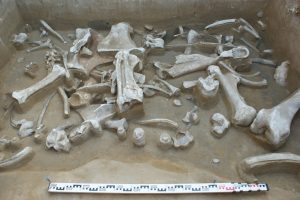
Over a month, scientists and students ofTomsk State University (Russia) conducted an excavation in the Novosibirsk Region at one of the largest mammoth graveyards in Eurasia. Remnants of these ancient animals abound in the Wolf Mane area. But this time, researchers stumbled upon a very deep level of bones whose existence no one had suspected. At a depth of about 1.7 to 2.1 meters, paleontologists discovered the bones of young and adult mammoths.
“Initially, we opened two bone levels—that is typical for Wolf Mane. We found many interesting instances, and it seemed that there was nothing more,” says Sergey Leshchinskiy, head of TSU’s Laboratory of Mesozoic and Cenozoic Continental Ecosystems. “A week later, we were going to go home, but there is an unspoken rule to check the underlying sediments for at least two shovel depths. We opened one place, then another and realized that we would have 10 days more to dig.”
Digging deeper, the paleontologists discovered bone-bearing sediments with such a high number of residues that were not known either for Wolf Mane or for another mammoth site in Russia. The concentration per square meter, with a thickness of sediments to half a meter, exceeded 100 samples in some places. The researchers uncovered vertebrae, ribs, limb bones, and other parts.
According to the scientist, the remains of wooly mammoths that have been found at such a deep level at Wolf Mane have a very good state of preservation. They were buried under a layer of clay and sand in a small wash several years after the death of the animals. Notably, the researchers found a relatively large amount of anatomic articulation, which will help paleontologists to learn more about the place, find the causes of death of individuals, and determine their age, size, and other characteristics.
Paleontologists believe that the bones of the lowest level belong to the animals that came to Wolf Mane several thousand years before the mammoths, the remains of which other scientists began to find in the 1960s.
“Among the largest pieces is a thigh with the length of almost 1 meter 15 centimeters,” says Leshinskiy. “Probably, it belonged to a male mammoth aged 45 to 50 years, which weighed five to six tons or more, and its height with account of the soft tissues exceeded three meters. Its remains, perhaps, laid in the formation for 20 to 25 or even 30 millennia. We can determine it more precisely with the help of the radiocarbon analysis.”
According to scientists, a large difference in size between the mammoths of the lower and higher levels is explained by the fact that at the final period of its existence, this species had powerful pressure from unfavorable environmental factors. Judging by the fact that the signs of osteodystrophy are present in many remains of later mammoths, the animals were suffering from mineral starvation. That is what led them to animal black alkali soils, like Wolf Mane, where dozens of millennia later, TSU paleontologists found the remains of the largest mammals on the planet.
At Wolf Mane, scientists and students have revealed not only the remains of at least eight mammoths. Of 785 discovered findings, some teeth and bones belong to bison, horses, predators (probably fox or polar fox) and rodents. According to the researchers, this is only a small part of what Wolf Mane hides. In fact, as a mineral oasis for mammoths, it may yet hide the remains of hundreds or even thousands of individuals.
Note: The above post is reprinted from materials provided by Tomsk State University.










